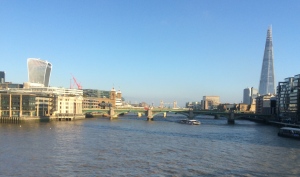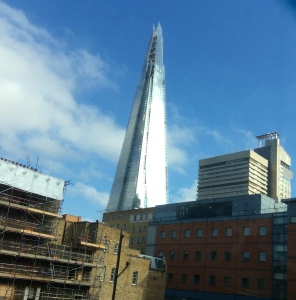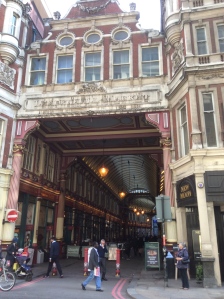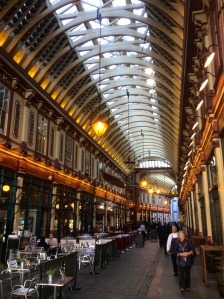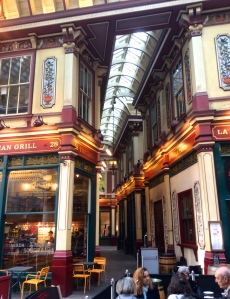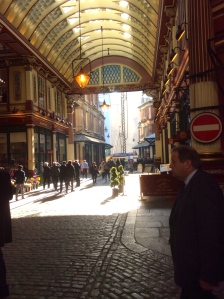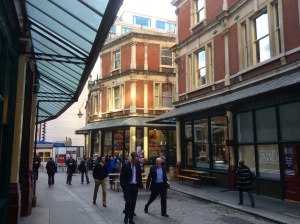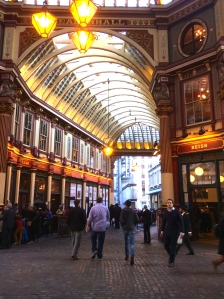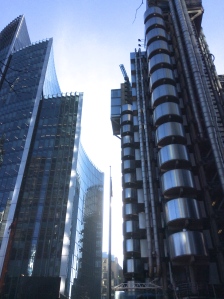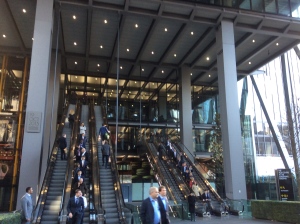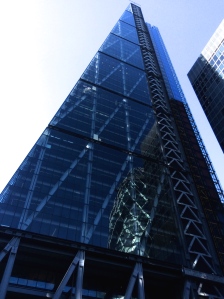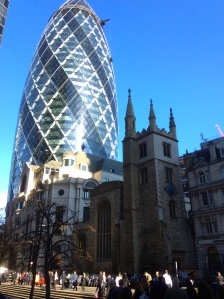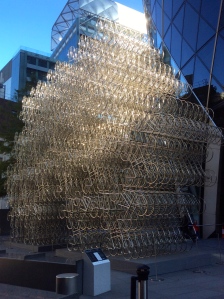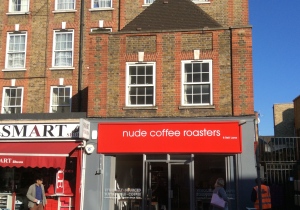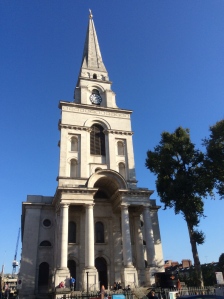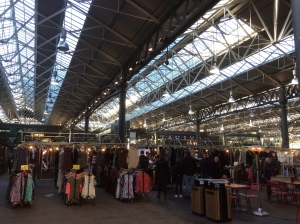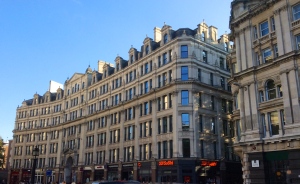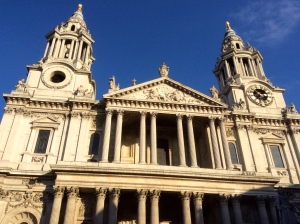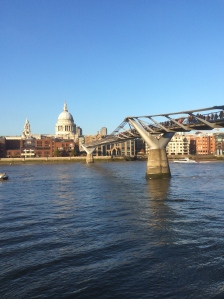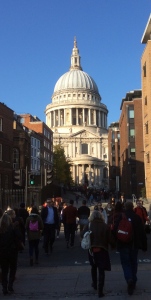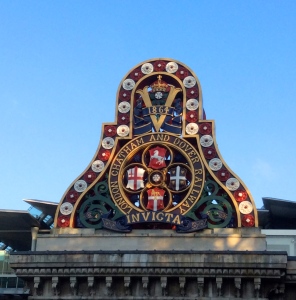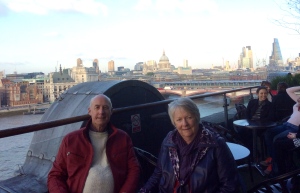We both love the City and had promised ourselves a visit to
Leadenhall Market, so we did this City of London Market Walk.
Haveing taken the boat back to Bromsgrove, for its winter
dry docking we have come up to London to see the family
and are staying in Clapham Common with our son Xavier.
Sue had also expressed a desire
to revisit her old work haunts which included, St Pauls,
and the markets in Brick Lane & Spitalfields,
thus we decided to jump on a No 35 Boris Bus,
from Clapham Common and
“Just Do It”
When in London, we always try to ‘Go By Bus’,
(top deck of course) there are always memories
to rekindle and something new to see.
This time it was the incredible redevelopment
going on around the Elephant and Castle and
of course the Shard, which jumps out at one,
from the gaps in the yellow sand-stock facades
which line the south west approach to the City.
Over London Bridge, the No 35 dropped us right outside
the main entrance in Gracechurch Street.
In the past, time had not permitted me to delve into,
what appeared to be a labyrinth populated by men in white coats
humping carcasses of who knows what along its cobbled streets.
If you look above the tables and below the fascia you can still
see the racks from which the carcasses were hung so they
could be inspected before purchase.
The main market street.
In fact the market is mainly formed by quite a small cruciform
arcade containing the original cobbled roadway, with a few
narrow paved alleys linking to other small access ways most
of which are protected by a magnificent glazed cast iron roof.
Originally for meat, game & poultry it is one of the oldest
markets in London dating from the 14th century.
The new arcade was designed in 1881 by the City Architect
who also designed Billingsgate and Smithfield Markets.
The cross street, Lime Street Passage.
Interestingly it is believed the site was used by two, Roman market forums.
The giant cork screw which can be seen, centre, is a pile boring
auger penetrating the site of an archaeological dig.
The area outside the main arcade, but still protected by glass awnings.
As the market grew steadily I would assume that this is an extension area.
Leadenhall Place
Note. The Lloyds building in the background,
another corkscrew, another market, another time.
The Lloyds Building
So typical of the City, the markets of Roman Britain, the
Middle Ages the Industrial Revolution and of the future,
all within 100 yard of each other.
The new Leadenhall Building.
It dos not stop there of course, across the road from the
Lloyd’s building is the 737 ft tall Cheese grater.
It was designed by Rogers Stirk Harbour
and Partners and opened last year.
Then over the road we step back just a few hundred years to
St Andrew Undershirt, a 10th Century church redeveloped in
the 1530’s, one of the very few City churches to survive
both the Great Fire and the Blitz.
But its large stained glass window was not so fortunate in
the philistine bombing which brought down the historic
Baltic Exchange building in 1992.
Then the Gherkin returns us to the future once more, built
on the site of the Baltic Exchange (yet another market) it
must be one of London’s most distinctive buildings.
This fabulous sculpture made from bicycle rims stands outside the Gherkin.
After the juxterpositioning of such dramatic spaces, history
and culture we walked through the more mundane streets
of Petticoat and Brick Lane. As it was mid week the only
excitement emanated from the incredible African and
Indian prints on display in the windows of the market’s
fabric shops. But this sign did catch my eye, as it
was meant to of course.
Over the road from the old Spitalfields Market stands Christ Church Spitalfields.
This beautiful Nicholas Hawksmore Church, was built in 1729
but became virtually derelict by the 1960’s.
After 25 years of restoration it was reopened for worship
in 2004 and the organ was recommissioned last year.
This is a must see.
The entrance to the old Spitalfields Market.
The last time Sue brought me to the market it was suffering from
planning blight as officialdom had decided to redevelop the area.
Fortunately the coster families campaigned to retain the old
market and managed save about half of it. It was also
agreed that many surrounding buildings would also
be retained to preserve the markets context.
So I was keen to see how things had turned out.
The old market is now full of independent traders and is thriving again.
The perimeter buildings have been improved to such an extent that
they are almost unrecognisable and the new market hall could
be a Shopping Mall anywhere between Sydney and White City,
it contains mostly brand names and was virtually dead.
After the City innovation and restoration we had
just passed through it was a very poor second.
Sue’s next destination was her old office which overlooked
the entrance to St Pauls.
This building was one of the very few which survived the Blitz.
I still can recall walking this area in the 1950’s when most of
what stood comprised 5ft high yellow sandstock brick walls, built
to prevent pedestrians falling into the bombed out basements.
(The Alec Guinness & Stan Holloway 1951 Ealing Films
The Lavender Hill Mob
gives some idea of what the City looked like in the 1950’s)
This film is a must see for anybody with an interest in
what is now old London.
To get here we walked through the second rebuild of
Paternoster Sq on the opposite side of St Pauls.
The first reconstruction was an appalling example
of 1960’s building design.
What a splendid outlook Sue had from her office window.
Sue had never been over the Millennium Bridge (Wibbly Wobbly Bridge)
and this was supposed to be our last destination for the day.
This must be one of the most iconic views in London,
previously it was only visible from the river for a few seconds
at the trip boats passed by, now it’s free to see for all.
But the view down river is just another river view !
It’s the end of the day, mission accomplished
time to take the LCDR home.
Only problem we had to walk past the OXO Building.
Somehow we end up on the roof,
and what’s that big black building in the background ?
The Cheese grater where we started!
What a great City.
